#some final fantasy cat designs are SO OBVIOUSLY final fantasy. it's endearing
Explore tagged Tumblr posts
Text
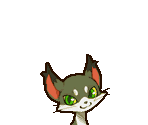
Coco from Cid and Chocobo's Mysterious Dungeon: Labyrinth of Forgotten Time DS+
#cat#final fantasy#chocobo dungeon#Cid and Chocobo's Mysterious Dungeon: Labyrinth of Forgotten Time DS+#some final fantasy cat designs are SO OBVIOUSLY final fantasy. it's endearing#named
14 notes
·
View notes
Text
FFVII:REMAKE - A Review
So I beat the game two weeks ago and started writing down my thoughts while they were fresh in my mind, but I didn’t post anything then because my one IRL friend who is also playing it hadn’t finished it yet and I didn’t want to risk posting anything spoiler-y. But the extra time has allowed me to play through the game again on Hard difficulty, which has allowed me to reconsider and elaborate on some of my thoughts. And frankly at this point I just need to dump my Very Big Opinions somewhere, so... here ya go.
I discuss visuals, gameplay, character and story below. I’ve tried to keep spoilers minimal up front, though obviously if you want to go into the game totally cold, don’t read this. All major spoilers are clearly tagged. All of it is below a cut to spare your dash.
Also, there are pretty pictures, because why not?
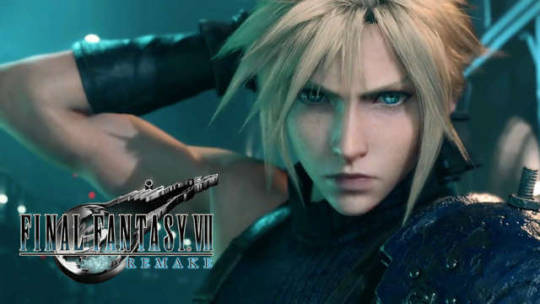
First, my background with this franchise: I played through the original FFVII multiple times; I’ve watched and rewatched Advent Children and Last Order, played Crisis Core, gave up on Dirge of Cerberus despite my deep love for Vincent Valentine (sorry, VV, but your game was just a mess), and lamented that Before Crisis wasn’t available in my country. I even played (and own!) Ehrgeiz, the obscure fighting game that featured the main cast. (Still bitter that they didn’t keep Miki Shinichirou as the voice of Sephiroth. He’s one of my faves.)

^ Ehrgeiz, a mediocre fighting game that forever endeared itself to me by including Turks!Vincent Valentine as a playable character. 💖
In short, I’ve been waiting for this game for DECADES.
So. Here we go. My thoughts on Final Fantasy VII: REMAKE.
The good:
The character models are very pretty. With individual pores, threads and scuffs visible, they’re so detailed that it’s almost impossible to reconcile them with the mouthless sprites from the original game – even more so than Advent Children (and dear goodness, that was over a decade ago now, wasn’t it?). Still, they’ve kept the costume details and absurd proportions largely intact (Barret’s fists are literally larger than Tifa’s entire head, yet somehow it works visually), so it’s not too much of a departure from the familiar.

They’ve kept the aesthetic. I was afraid the game would try to update the iconic world of Midgar, but by and large, it’s full of visually-arresting designs that preserve the gritty-industrial look and feel of the original.
Japanese version is included. BLESS YOU, Square Enix, for including the Japanese voices and character animations. Not only is it impossible for me to hear Cloud in anything other than Sakurai Takahiro’s voice, but the Japanese script is a bit nicer to the characters. I’m not really keen on the English dub… but more on that below.
They fixed the spelling of Aerith’s name. This may seem like a minor point, but considering it’s been 20 years and I’m still bitter that Devil May Cry still hasn’t corrected “Nelo Angelo,” it’s a small victory.
Improved combat. Admittedly, I wasn’t sold on the new combat system at first, but after playing through the game twice, I’ve come to really like it. It has a few rough edges and can get chaotic in some battles, but it does a decent job of blending the feel of an action game with turn-based strategy. The fact that you can switch to a more traditional turn-based system if you prefer is also nice. (I haven’t tried Classic mode yet, though.)
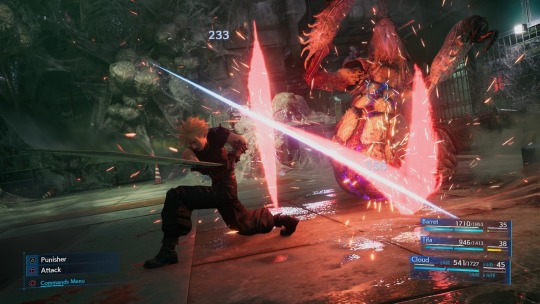
Weapon customization. The Skill Points system allows you to upgrade your loadout instead of acquiring new gear. The tutorial was somewhat lacking (I didn’t quite figure out the multiple-core-unlock thing right away), but I appreciated the ability to add materia slots or stat buffs rather than just cycling through a dozen swords that Cloud apparently keeps in his back pocket.
Background dialogue management. On the whole, the conversations as you run through town enhance the story without slogging down the gameplay; you don’t have to stop and talk to every single resident, because snatches of their conversation reach you (and your on-screen chatlog) as you pass. You can stop and listen for more detail if you want, or you can just keep moving. The extra worldbuilding is really nice.
The music. The orchestrated versions of the original themes are excellent (and some of those music cues gave me goosebumps… Did I spend way too many hours immersed in the original game? Probably). I can take or leave some of the collectible jukebox tunes, but the background music in general is good. (But did I earn that Disc Jockey trophy? Yes, yes I did.)
Supporting character development. Jessie, Biggs and Wedge actually have characters! And personalities! Clichéd ones, admittedly, but it’s an improvement over the original game killing them all off within the first few minutes. The game also does justice to the Turks, and actually surprised me with how much depth of character it gave Reno and Rude in particular (perhaps setting them up for a mini redemption arc so players forgive them for dropping a plate on tens of thousands of slum residents?). Their moments of concern for each other and (brief) crises of conscience made them more than the stock villains they were in the original game, more in line with their temporarily good-aligned characters in Advent Children. Tseng, likewise, was on point. However, I do have to qualify all this with one irate question: Where the heck is Elena?! Seems like the female characters are always getting left out… /sigh/

Improved plot devices. REMAKE cleans up some of the more questionable and outdated content from the original. As you likely already know from the demo, the new game somewhat exonerates the protagonists by having Shinra blow up their own mako reactor to turn public opinion against AVALANCHE (possibly because someone finally realized that it’s hard to sympathize with characters who are willing to melt down an entire reactor and kill a bunch of innocent civilians). AVALANCHE are still eco-terrorists, but they’re… terrorists with a conscience? I dunno, at least they feel bad when people die now… Likewise, the weird and uncomfortable Honey Bee Inn segment of the original game has been reborn as an amazing dance extravaganza. Less voyeurism/prostitution, more Vegas floor show (complete with minigame choreography) and makeover. The whole Don Corneo scenario is still hella creepy, but frankly, there’s nothing that can fix that.

Series references. Fans of the original will appreciate all the inside jokes and direct references to the original game and other franchise entries: One-off comments about Chocobo racing; a broken console in Wall Market that shoots at you; a framed picture of the original 32-bit Seventh Heaven; ads for Banora apple juice; side mentions of characters and plot devices from spinoff games; PHS communication… The game definitely pays tribute to its history. They even recreate the original loading screen and several of Cloud’s iconic poses/animations throughout the game:


The neutral:
Recycled gags. Look, I know Advent Children was the ultimate evolution of FFVII for a while, and admittedly, it did some things very well. The running gag with Rude’s sunglasses and the victory fanfare being used as a ringtone are some of the best moments in the film, in part because they were so unexpected. But as much as I enjoyed the repeated nods to AC in this game, they felt a little desperate, like there were no new jokes to insert so they had to double down on the ones they’d used the last time this franchise had a renaissance. (See Rude’s broken sunglasses, below.) And fitting into the series as a whole, it feels a little weird. Why is Rude’s ringtone the same as the clones’ from Advent Children? Does Barret really need to sing the victory fanfare over and over when he defeats an enemy? Is there supposed to be some history behind that song that was left out of the worldbuilding? It just feels too meta.

Arbitrary localization of names. I don’t really grasp why it was necessary to rename so many items and characters for the English market. Some changes make sense for localization (e.g. Whack-a-Box certainly works better for an American audience than Crash Box), but others seem arbitrary, like changing Aniyan Kunyan to Andrea Rhodea or Mugi to Oates (a play on the meaning of his name in Japanese, but... does it matter?). And then… well, I don’t want to spoil A Major Plot Element, but there’s another thing that changes names from one English word (in the Japanese track) to a different English word. Why? No idea. It doesn’t affect gameplay, and it’s not really a problem, but listening to the Japanese track, I found it jarring to have the subtitles contradict what I was hearing.
Underutilized characters. While the whole gamut of original FFVII characters make appearances, several of them aren’t used to full effect, or aren’t used at all to advance the story. Rufus Shinra’s bossfight is a decent challenge, but while his character was vital to both the original FFVII and Advent Children, his presence in this game is little more than a cameo. His fight could be cut or swapped out with any other boss, and it would have zero effect on the plot. Similarly, while Hojo is a key player in the full story (which this game doesn’t cover, since it’s only a fraction of the original timeline), he’s largely wasted here, except as a means of extending play time by making you wander through corridors and fight a bunch of monsters for “research.” (I have no idea what his motivation is; you’d think he’d be more interested in recapturing Aerith or Cloud, but instead he just... opens an elevator and lets them leave? after they beat up some midbosses.) Reeve Tuesti actually has a solid presence in this game, but since he’s ONLY ever active as himself, there’s no explanation for the random Cait Sith cameo in one scene (players new to the franchise probably have no idea why a random cartoon cat showed up for a few seconds and was never mentioned again). Obviously the plot arcs have to change when the game is covering only a few days’ time in a much longer story, and the major players need to be introduced at some point if they’re going to feature in later games in the series, but from a narrative standpoint, there are an awful lot of superfluous characters doing things for no reason in this installment.
The bad:
THE PADDING. Dear goodness, there is so much padding to make this a standalone game instead of just the first chapter of a longer adventure. I got really, really sick of running literally from one end of the map to the other on side quests – and that’s me, an avowed trophy hunter who spends hours scouring dark corners for collectible items in other games, saying that. So much of this game felt like time fill that didn’t really advance the story. It’s also full of unnecessary new characters with improbable Squeenix hair, like Roche the super-annoying motorcycle SOLDIER (below), or Leslie, Don Corneo’s doorman who somehow merits his own backstory and side quest. (Though in fairness, every FFVII sequel has added superfluous characters, with Crisis Core possibly being the worst offender.) But it just felt really drawn-out and bloated for a game of this generation. If this game had been as compact and tightly-written as the other games I typically play, it probably only would have taken me 15 hours to beat instead of 50. (I don’t actually know how many hours I spent on it the first time through, as I didn’t check the play clock before restarting on Hard difficulty. I do know it took me over 110 hours total to complete the game on both modes, though much of the second run was spent dying repeatedly on a handful of nasty fights. Hard mode removes items and MP replenishment, and if you run out of MP at any point during a chapter, you’re going to die. A lot.)
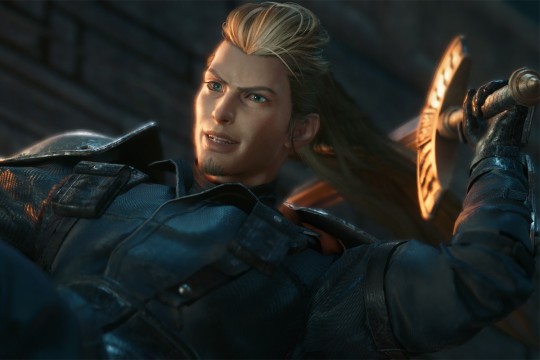
The pacing. Related to the above... the Midgar portion of the original game was just the setup for a larger story. It wasn’t meant to have its own complete dramatic arc so much as to introduce you to the world and the major players. Consequently, there are some really odd beats in this story, as well as a total lack of urgency in your mission. There are no natural places to slot in the side quests and minigames, so they’re shoehorned awkwardly between plot sequences. “Quick, our friend is in mortal peril and needs our help!” "Okay, cool, we’ll go rescue her after we spend ten hours running around town doing random errands for townspeople and playing games with the local kids.” Uh... what?
The graphics just aren’t as good as they should be. While the character models are gorgeous, there are a lot of low-res background textures and weird polygons that don’t quite match up with other components. Most egregious are the Shinra logos, which frequently get close-ups as part of the fixed camera work and, frankly, look like lossy JPEGs. (See image below, screencapped from a PS4 Pro. Those jagged edges on the logo are present throughout the entire game.) There are weird clipping errors and artifacted images and reflective surfaces that don’t reflect, making the game look more like something from the PS3 era than a 4K late-gen PS4 game. (And it’s not that we don’t have the technology: Uncharted 4 was released back in 2016, and the rendering of its vast world was twice as pretty. Devil May Cry 5, released in early 2019, has far more realistic textures and object interaction. Granted, those are different types of games with fewer NPCs to render, but I feel like there’s no excuse for a game this big to look this mediocre.)

The HUD could be better. The lower-corners concept is okay, though it took me a while to train my eyes to travel between both sides of the screen and track the fight action. But for a long time, I didn’t even notice the commands in the upper left corner of the screen, and after playing through the game twice I still have no idea what they say because I couldn’t focus on the tiny text long enough to read them while trying not to die in combat. (I just looked it up; apparently they’re combat control shortcuts? Huh, that would have been useful to know.) It wasn’t until my second time through that I realized there even WERE separate controls on screen during the motorcycle minigames; I had resorted to panicked button mashing to figure it out the first time through because there was no tutorial (you’re just dropped into the action) and, having ignored the small text for the previous hundred combats, I had no reason to look for on-screen instructions there. Not that it would have helped, since on many backgrounds the text in the upper left is really difficult to read (see below). It’s worth noting that I have better than 20/20 vision and played this game on a large TV screen and still had trouble reading some things; on a smaller TV, or for someone with less acute vision (like my sister, who is blind in one eye), I think even the basic menu controls would be difficult to see. While you can resize the font for subtitles, my cursory glance through the menu did not uncover an option to increase the size of the HUD.

Inter-fight menu mechanics. Specifically, the inability to save (or save loadout settings) between fights in a multi-part sequence. There are several back-to-back fights in which it is necessary to switch characters or change gear between bosses. The game treats them as one continuous fight, though it does allows you to access the equipment menu by holding square during key cutscenes. Which is good, if you only have one of a particular materia or accessory that you need to switch between characters, and in most cases when you die the game lets you restart just before your current fight instead of restarting the whole sequence -- also good, since some multi-stage bosses can easily take 20-30 minutes to beat, and if several of those are strung together in sequence, you’re in for a long play session to get past them. But since it’s treated as one fight, you can’t save between bosses (more than once, I had to leave my PS4 running in Rest Mode overnight and just hoped we didn’t have a power glitch), and if you happen to get killed and need to restart the fight, your loadouts reset. Which means if you’re, say, fighting the end boss on Hard difficulty and get killed in the first two minutes -- which happened to me a lot -- by the time you restart the fight, sit through the unskippable cutscene, access the menu and rearrange all the materia and accessories you need, you’re spending five or six minutes gearing up for two minutes of play, and then doing that over and over again every time you die. It gets really old.
The English dub script. *deep breath* Okay, look, I know I can be a bit elitist about translations, but I really do not like the English adaptation of this game. It makes Cloud come across as less socially-awkward and far more of a deliberate jerk, Aerith is mouthy and even swears (which is not accurate to her original character), and it downplays some of the symbolism that’s more obvious in the Japanese script. One quick example: When Aerith gives Cloud a flower, she says (in Japanese), “In the language of flowers, this means ‘reunion.’” It’s subbed/dubbed in English, “Lovers used to give these when they were reunited.” That’s a subtle difference, but since the concept of “reunion” is a freakin’ huge part of the FFVII plot, and since Sephiroth was on screen literally seconds before that line is delivered, my brain automatically went, “OMG REUNION!!!” while I’m guessing people listening in English only picked up on the romantic subtext. It’s a pretty minor thing, and of course translation is always a complex balancing act between literal meaning and local market understanding, but the English version just seemed to me to have a different vibe overall. (Unfortunately, the English subtitles are the same as the dub, so unless you can understand the Japanese audio you’re kind of stuck with that dialogue.)
-
-
[WARNING: SPOILERS BELOW THIS POINT]
-
- …And my #1 complaint about Final Fantasy VII: REMAKE is…
…it’s not actually a remake.
Sure, the game starts out the same way and covers a lot of the same events, but fundamentally, it’s a sequel, not a retelling. It’s evident from Cloud’s future-oriented visions throughout the game that something else is going on, and the ending MAKES NO SENSE if you don’t already know the story. Heck, even the rest of the game doesn’t really make sense if you don’t know the story -- Sephiroth’s presence is never explained; Zack isn’t even introduced, just shows up randomly at the end; Cloud’s flashbacks of Tifa and her dead father in Nibelheim are left as a complete mystery (and since she evidently remembers the burning of her town, judging by her dialogue outside Aerith’s house, why doesn’t she even react when Sephiroth shows up?).
The core elements of the plot – the Feelers (Whispers) preserving a specific fate; the three entities from the future (whose weapon types just happen to correspond to certain named characters) defending their timeline; the return of post-Advent Children Sephiroth (the only time we’ve seen him in human form with one black wing), who has inhabited the Lifestream since his death and promised that he would never truly disappear, who in the end appeals to Cloud directly for an alliance rather than attempting to control him, because he knows now that Cloud is strong enough to defy the Reunion instinct; the change in the outcome of story events in which Biggs (and, unconfirmed as to which timeline he’s actually in, but quite possibly Zack) now survives his intended death -- all point toward Sephiroth trying to manipulate destiny into an alternate outcome in which he is victorious, and using this naive version of Cloud to facilitate it. That means this game is taking place in an alternate or splinter universe, created at some point after the events of the original Final Fantasy VII, and possibly even after the events of Advent Children.
All of that is fine from an overall continuing-story perspective – it opens up a lot of interesting possibilities, like the fact that Aerith might survive now that Cloud has seen prescient flashes of her death (among other events), and there are opportunities for more story twists and changes from what players might expect. But touting this as a remake of the original game has the potential to confuse players who are new to the franchise. FFVII was groundbreaking back in 1997, and it defined JRPGs for an entire generation of Western gamers. But that was more than two decades ago, and a lot of current gamers weren’t even born then, so while they’ve probably heard of the classic game, they aren’t necessarily steeped in its lore. FFVII:R relies heavily on prior knowledge of the series to carry its twist ending, so it largely fails as a standalone game.
Also, speaking as a longtime fan of the franchise… I honestly found the ending rather lackluster. It was a twist, of sorts, but not the sort of shocking, mind-bending revelation that made the first game so iconic. Granted, it’s hard to follow an act like revealing that your protagonist’s entire identity is a lie, not to mention killing off one of your main characters a third of the way into the story! But when the surprise ending is just, Surprise! We’re going to change things up a bit this time around so you aren’t entirely sure what’s coming! Also, here’s a gratuitous Sephiroth fight because everyone expects that, even though it doesn’t serve the main story at all nor resolve any conflicts previously established within this game! it smacks of Different for the sake of Being Different, not for the sake of a really amazing storyline they’re hiding up their sleeve. It’s a bit of a let-down, and I find that I... just... don’t really care that much. Which, for someone who’s been a fan of the series for nearly a quarter of a century, means there’s a Big Freaking Problem somewhere. If you’re not keeping the attention of your die-hard fans, how do you hope to build a fanbase of players new to the franchise?
Given the pacing and story issues inherent in this game, I’m not convinced that the following game(s) in the franchise are going to be structured any better. Considering the amount of pure side-quest padding they did in Midgar, I have no idea how they’ll maintain that same tone on something the scale of the World Map portion of the original game, unless they just completely eliminate things like Fort Condor and the submarine and the spaceship side quests. I have a feeling the Gold Saucer is going to be reduced to a Jessie flashback, a Chocobo race (probably to win a key item), and a battle arena run like the coliseum in Wall Market in this game. If they include all the story elements and side characters from the original, this series is going to be a dozen games long.
Still, on the whole this game was enjoyable, and I’m glad I played it. It wasn’t as good as I’d hoped, but they haven’t completely killed off my interest, so I’ll probably continue with the series whenever the next game comes out. Though I’m not really sure if the higher-priced edition I pre-ordered was worth the extra money, so I may wait and see how the next game is shaping up before deciding which version to get...
But if they don’t give me a really pretty (playable) Vincent Valentine in the next installment, I may riot. I do have priorities.
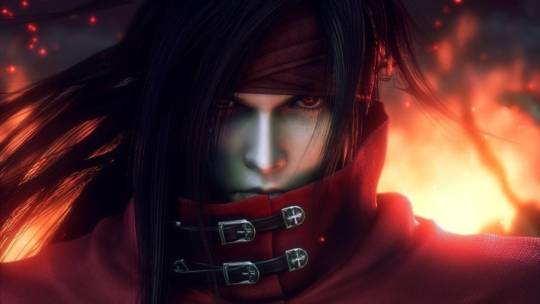
#final fantasy vii#final fantasy vii: remake#ff7:r#final fantasy 7: remake#ff7 remake#video games#long post#review
9 notes
·
View notes